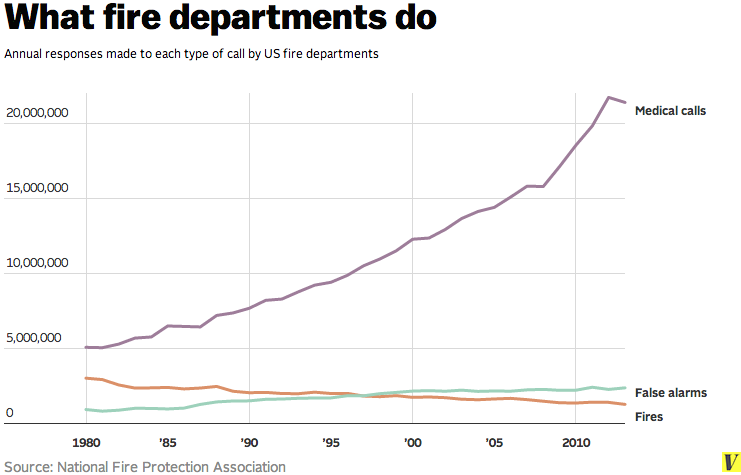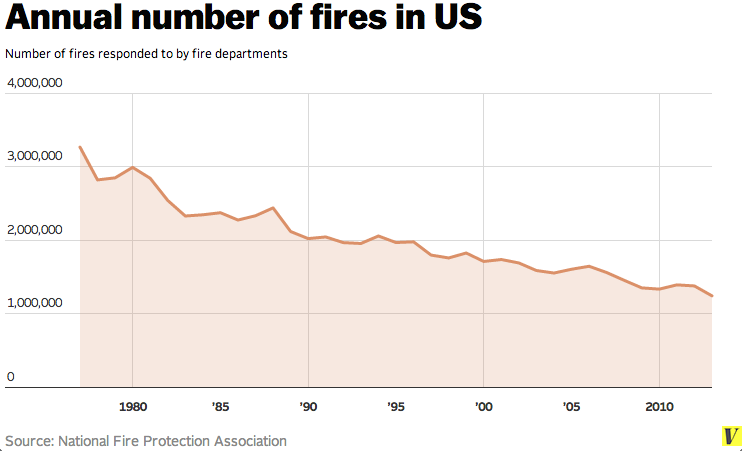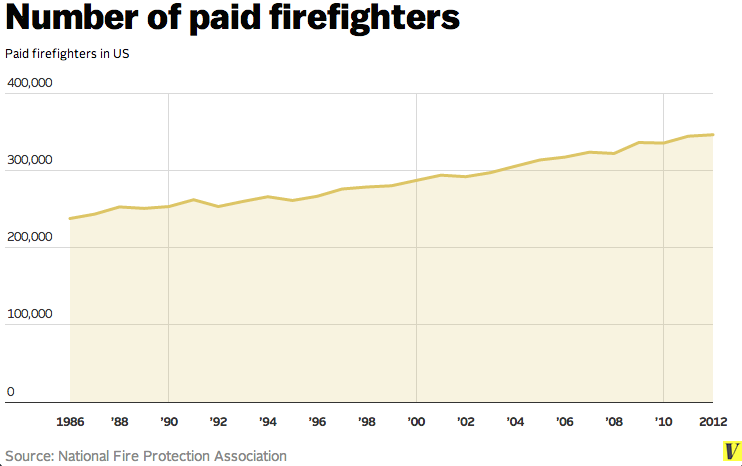A little known fact is that over the past 40 years, the number of fires in the US have dropped dramatically. Consider this chart from Vox, based on data from the National Fire Protection Association (NFPA):
The number of fires responded to by municipal fire departments in 2013, about 1.2 million, is roughly a third of the 3.3 million responses in 1977. Note that these numbers don’t include wildfires, which aren’t dealt with by local fire departments and as Vox reports, keep getting worse.
And since the US population has increased by 44% during that same period, this is a pretty remarkable trend. It seems that most of the improvement can be attributed to things we would expect: stricter fire codes, fireproof building materials, cars that catch on fire less often, and installation of protective devices like smoke alarms.
Yet, during the same period, the number of firefighters has increased:
Paid firefighters have increased by roughly 48%, from about 230k in 1986 to about 340k in 2012, in line with the population growth. The number of volunteer firefighters has remained the same. We now have more firefighters fighting fewer fires. So, what are all these firefighters doing?
Firefighters now respond to many more medical calls per year than actual fires. In fact, the chart below shows that fires and false alarms held steady or declined, while medical calls grew from 5 million to about 22 million by 2012. There is also a slightly better chance that the fire engine is responding to a false alarm than to a fire:
 The decline in fires has put firefighters in a curious position. What should they be doing to justify their (in most cases) growing budgets? Vox quotes Libertarian economist Alex Tabarrock of George Mason University:
The decline in fires has put firefighters in a curious position. What should they be doing to justify their (in most cases) growing budgets? Vox quotes Libertarian economist Alex Tabarrock of George Mason University:
Firefighters face what I’ve called the ‘March of Dimes’ problem. After polio was cured, the March of Dimes looked around and said ‘what do we do now?’ Firefighters have been facing the same problem.
Now, there is little in city life that is more reassuring than walking past the neighborhood fire house. It reminds us that there are people in our employ who are ready to strap on equipment and head into danger to help out one of our neighbors. But it wasn’t always that way:
The Wrongologist may be one of the last persons who remembers when homeowners paid a fee to a for-profit fire department to protect your property. That was in Brooklyn, NY in the early 1950’s. The fire company placed a medallion on the homes of their “clients”, and didn’t protect any homes without medallions. There was no public FD service in that neighborhood until the late 1950’s.
The Boston Globe reports that the Boston FD accounts for 7.5% of the city’s total budget, while NYC spends $1.72 billion on its FD. It is difficult to tell people that fewer firefighters will keep them just as safe, and the political fall-out for any mayor who tries to dramatically reduce firefighter head count would almost certainly be gruesome. Talk about poking the bear.
But what is the highest and best use for idle firefighters? Could cities work to slowly transfer firefighters to EMT, Park Rangers, Inspection Services or other city jobs? What about the pay differences? There are always efficiencies to be gained in public jobs. It seems sensible to start reducing staffing levels and adjust the number of fire stations, given the occurrence of fires.
Efficiencies might be found by using better processes, such as integrating the dispatch services operated by EMT and Fire, or by using different tools. For example, if cities want to use firefighters as extra paramedics, maybe sending smaller trucks or motorcycles equipped with oxygen for cardiac situations, might be workable. The motorcycle would likely get on site sooner, and the crackerbox EMT truck could follow behind for transportation of a patient to hospital. There would always be some extra portly people who can’t be carried down 5 flights of stairs by 2-3 people, so they would have to wait for reinforcements. But there should be no need to dispatch a fire truck just to be sure more lifting power is available if needed.
Natalie Simpson, a SUNY Buffalo professor who studies the history of emergency response, says that because of the nature of the demands we put on fire departments, we can’t really shrink their ranks, and there are problems with putting them in different vehicles too:
If you say, ‘there’s very few fires, so we don’t need as many firefighters or fire engines,’ a fire is still eventually going to break out…And without the same response resources, you’re going to have the same number of very few fires, but some of them are going to become catastrophic.
Her view is that we need to have a surge capability to respond in any given area to make sure that the few fires that do occur can be put out quickly. We can model those issues as we ALWAYS do in the private sector, to determine optimal staffing and equipment for the required level of response.
No one should be saying that firefighters aren’t heroes, or that they didn’t show amazing teamwork and bravery when on the scene of a fire. But all that bravery should not by itself, justify inefficient numbers. Every dollar we can save is a dollar that can be better used elsewhere.



The reduction is fires is the natural and expected result of grounded electric services (the old knob and tube was not grounded) the reduction in smoking, the reduction in the use of wood, kerosene et al for household heat and cooking. But as for the fire fighting companies, maybe we need to retool, but the nature of a widely dispersed population means that we need more capacity not less (so fire stations in western NJ for example where there once were none). Or in Beavercreek OH (yet Fairborn still needs its stations). There may be some efficiencies but it is hard to imagine how. Lots of stuff looks great on a blackboard but fails in real life (like aligning the compensation of officers with the company – a 1960s business school idea that eventually led to cooking the books).
In fact, in rural areas, sometimes the fire company needs more equipment – water tankers for example.
@Terry: we should retool. I have lived in rural New Hampshire where our volunteer FD could not get to a fire in less than 30 minutes unless it was right by the fire house. Their joke was “we’ve never lost a foundation”. But niether suburban sprawl nor population growth justifies the growth in FD personnel. Fires per capita have also fallen. FD’s in adjacent towns (or neighborhoods in cities) always support each other and surge people & equipment when needed.
Today I live in a town of 25,000 that has the largest land area in CT. There is no hydrant within a mile. Most fire companies here are volunteer. Even here, most calls are for medical emergencies.
The point is that we have the tools to plan optimal staffing/equipment levels to meet short and longer term needs, and we should be talking about how to move toward optimum levels.
I don’t entirely disagree. And in clifton nj when i was a boy, our fire department did police patrols. still, i worry about taking a good idea and having it rammed home as a panacea. i too live in a town served by volunteer. their motto is that they never lost a foundation.